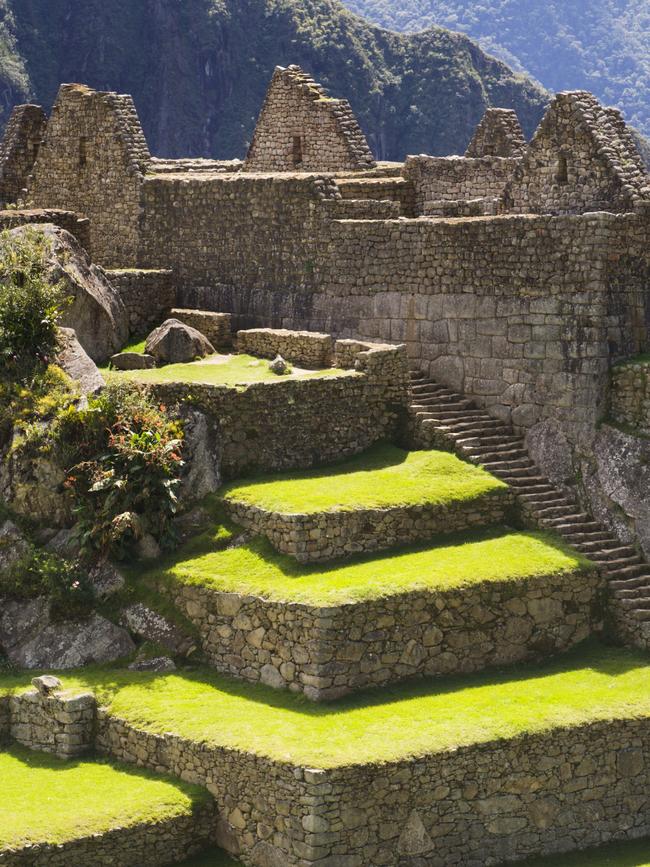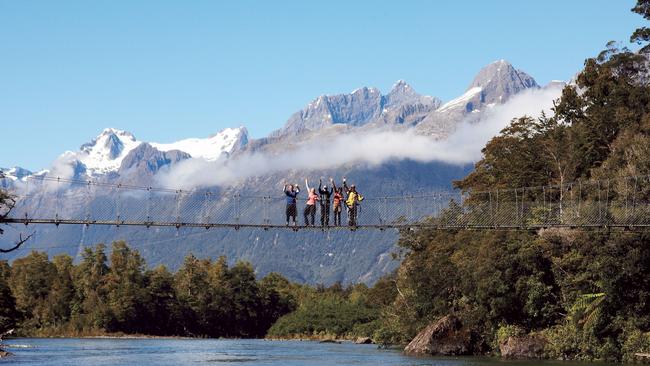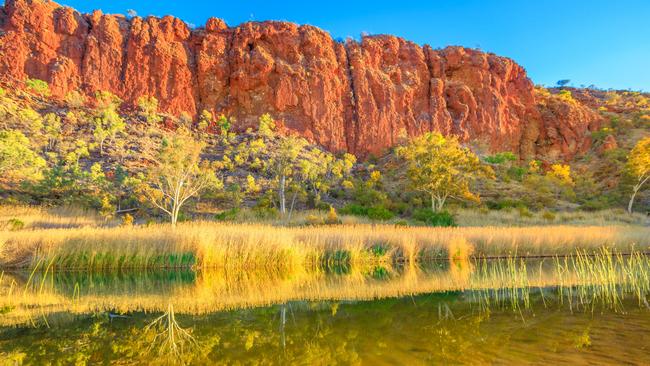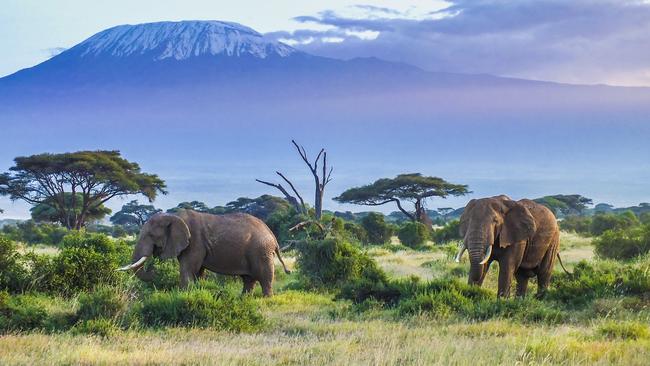Take a hike
Avid hikers can add these trails to their bucket lists.

1: APPALACHIAN TRAIL, US
Got half a year to spare on a long, hard stroll? That’s the average time it takes to complete the Appalachian Trail, a 3540km footslog from Georgia to Maine in the eastern US. “Thru-hikers” attempt the full trail in a single season (although only 20 per cent succeed) while others prefer to “section-hike” it over the course of several years. The 260 shelter huts dotted along the “AT” can be surprisingly crowded from mid-March, the preferred starting time for the northward trek. Most hikers, who spend an average of $1500 a month on gear, supplies and sundries, will take between five and seven months to complete the route. The record-holder is a Belgian ultra-runner who tore through it in seven no-doubt blistering weeks; appalachiantrail.org.

-
2: CAMINO DE SANTIAGO, SPAIN
“Doing the Camino” is shorthand for walking El Camino de Santiago — the Way of St James — a web of ancient pilgrimage routes converging on Santiago de Compostela, northern Spain. The Camino has bloomed far beyond its origins as a journey of penance and contemplation. For some today it is a bucket list box-ticker and for those who provide tours or services along the way, it’s a good earner. Modern “pilgrims” walk or cycle it, travel solo or in a group, or even indulge in foodie tours. For extremists there’s a redemptive, 21-day package at $25,000 a head. Among the numerous Camino routes are the UNESCO-listed French and northern Spain trails, while popular “Camino lite” packages promote the last hundred kilometres; caminoways.com.
-
3: MT EVEREST BASE CAMP, NEPAL

With a Sherpa in the lead, we confront a concertina of ever-rising ridges that might break one’s pedestrian heart, but the view from each summit boots it right back to exhilaration. The popular (if not too popular), two week-plus tramp to Mt Everest Base Camp climbs over rickety suspension bridges and past rhododendron forests, cranky yaks and hilltop monasteries. Entering the Khumbu highlands, you’re in serious high-altitude terrain where the grand conference of Himalayan gods — Everest, Nuptse, Lhotse, Ama Dablam — looks down on your plodding progress. With base camp reached at 5364m, the bonus is to leg it higher still to 5644m Kala Pattar and to stare great Sagarmatha, Mother of the Universe, aka Mt Everest, right in its awesome face; intrepidtravel.com.
-

4: INCA TRAIL, PERU
The Cordillera de Vilcabamba mountain range towers above us as we climb through its forests and hike along alpine ridges. We’re following the fabled Inca Trail on a supported 43km, four-day hike. In places, the trail’s 500-year-old stone causeways are still perfectly intact, as are its extraordinary Inca fortresses. A lung-busting ascent leads to the trail’s highest point, at 4420m, the ominous Dead Woman’s Pass; a time and place to drink in the vast Andean view. On the final day we sight our goal, the never-really-lost city of Machu Picchu. On seeing its labyrinth of temples built in intricate jigsaw stonework, the poet Pablo Neruda wrote: “A permanence of stone and language upheld the city raised like a chalice”; alpacaexpeditions.com.
-
5: HOLLYFORD TRACK, NEW ZEALAND
You’re striding through Middle-earth reclaimed, a Kiwi wilderness of greenstone lakes and waterfalls — and there’s not a Tolkien hobbit, orc or elf in sight. This is Aotearoa before the Lord of the Rings movies shanghaied our imaginations. To see it, hit the Hollyford Trail on the west coast of the South Island. A commercial, three-day hike amid its glacier-carved grandeur sees you lodge nicely at night, with cold sundowners and hot showers. By day you walk a gauntlet of thousand-year-old rimu trees, rattling rivers and shimmering ferns until reaching the sea at Martins Bay. Then, learning that the Maori name for this realm of gothic mists and jagged peaks translates as Shadowlands, you’re suddenly transported back in Tolkien country again; hollyfordtrack.com

-
6: LARAPINTA TRAIL, AUSTRALIA
“Pull up a soft rock and have a break,” says our guide as we reach a peak in the West MacDonnell Ranges. Groundswell ridges stretch to the horizon in a panorama of pure Namatjira colours. Beside me is a chunk of ancient “ripple rock”, formed 300 million years ago when this and all Central Australia was a seabed. We’re on the 223km Larapinta Trail, one of Australia’s most famous treks. The route can be enjoyed in shorter versions via a series of supported day-hikes where you return to base camps each evening. Hiking here is challenging, with the heat like a microwave as you climb amid basalt slopes and silver-trunked ghost gums. But then at dusk comes the campsite, billy tea, damper, boots off, a swag. You beaut; worldexpeditions.com.

-
7: MT KILIMANJARO, TANZANIA
It’s the highest peak in Africa and at 5895m, no pushover. There are several routes to the top of Mount Kilimanjaro (the highest single, freestanding mountain in the world) but the equatorial temperatures that sometimes drop to subzero and the steep, rugged terrain demand a high degree of fitness and commitment. An eight-day, non-technical ascent, for instance, on the Marangu Route, even though porter-supported and with overnight huts, is rated “strenuous” with hikes of six hours or more on most days between huts. Altitude sickness is common. On your summit day — the ultimate “hump day” — hikers start out at midnight and walk for up to 16 hours to finally celebrate standing on “the roof of Africa”;
gadventures.com.au.

-
8: LAUGAVEGUR TREK, ICELAND
It’s a trail of fire and ice, so to speak. Iceland’s most renowned hiking route, the remote Laugavegur Trail, covers a relatively short 56km but the route is dense with forests, peaks, valleys, glaciers, black sand beaches and thermal springs, plus legends, of course. This five-day stint of Viking hiking traverses a myth-laden, post-volcanic landscape created when Thor, the god of thunder, reputedly brought his hammer down hard. The summer-only trek is rated “medium difficult”, with each day’s journey ending at a heated hut, and your food and gear being transported between stops. One of your extra challenges on the trek is learning how to pronounce local names such as Landmannalaugar, Hrafntinnusker and the infamous volcano, Eyjafjallajokull; mountainguides.is.

-
9: TORRES DEL PAINE, CHILE
Patagonia is “the farthest place to which man walked from his place of origin”, Africa, wrote author Bruce Chatwin. So it’s fitting that this dramatic landscape near the ultimate point of the Americas is a magnet for serious walkers. The horn-like peaks of Paine Massif, jutting to 2500m altitude, seem the ominous co-creation of geological tantrums and sabre-toothed winds. You’re trekking in the shadow of the towers, through a wind-chilled world of hanging glaciers, valleys and lakes with drifting, baby blue icebergs. The “W Trek” route around the Torres’ base, a UNESCO Biosphere Reserve, takes from five to 10 days, depending on your options. It can be done as a supported, self-guided hike with “refugio” hut accommodation, gear transfers and food supplies; howlanders.com.

-
10: TOUR DU MONT BLANC
Traditionally, hikers take 11 days to complete the 170km Tour du Mont Blanc around the base of Western Europe’s tallest (4808m) massif. Time and money being what they are, you can now do “express” versions in as few as eight days. The “TMB” is usually walked in a counterclockwise direction, starting from Chamonix, France, and then passing through Italy and Switzerland. There are also several alternatives, known as “variantes”. The traditional route traverses seven valleys and twice reaches a maximum altitude of 2665m. Accommodation, depending on your budget, is in campsites, mountain huts or hotels but, as this is one of Europe’s most popular long-distance walks, both the trail and stopovers can get crowded in the summer months of July and August; tour-du-montblanc.com.
